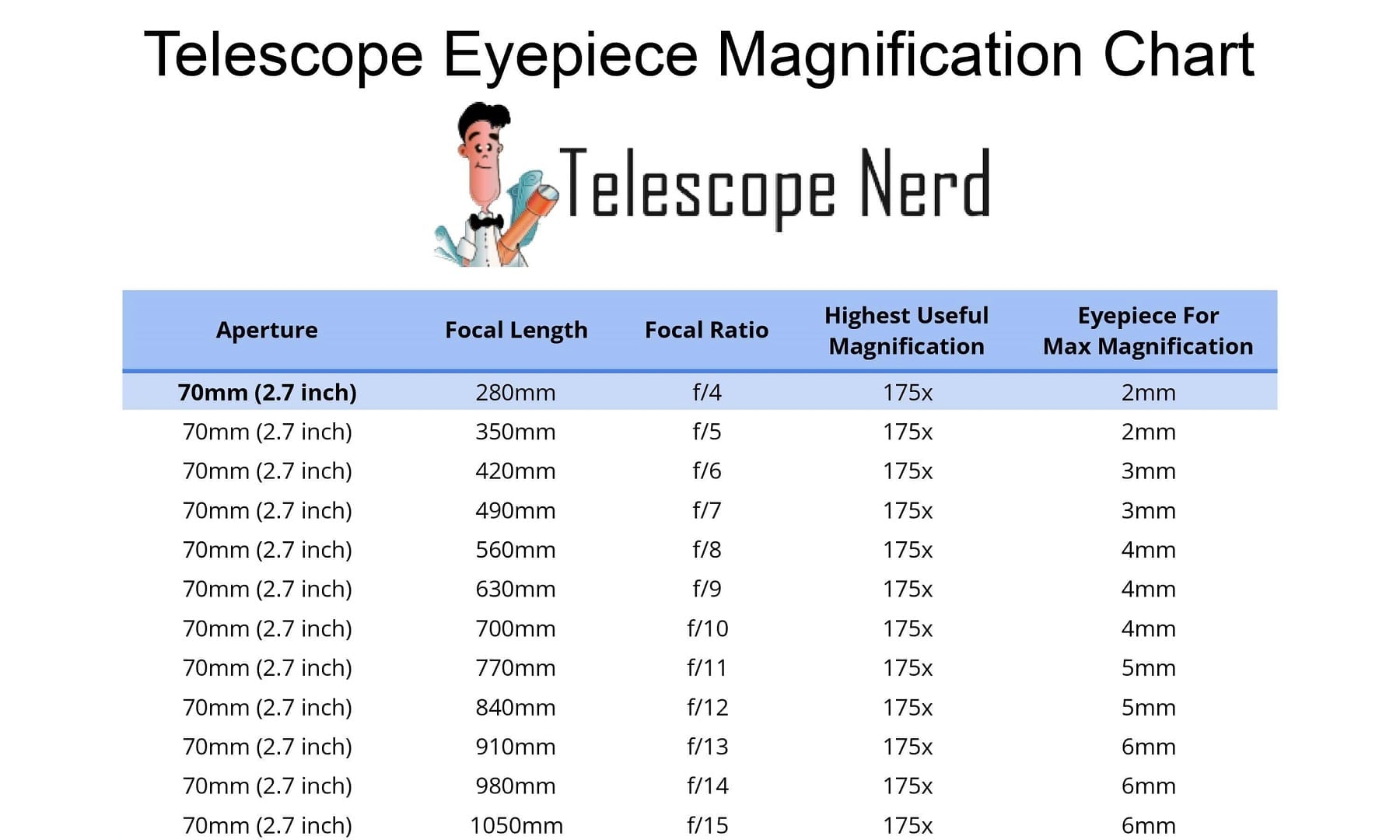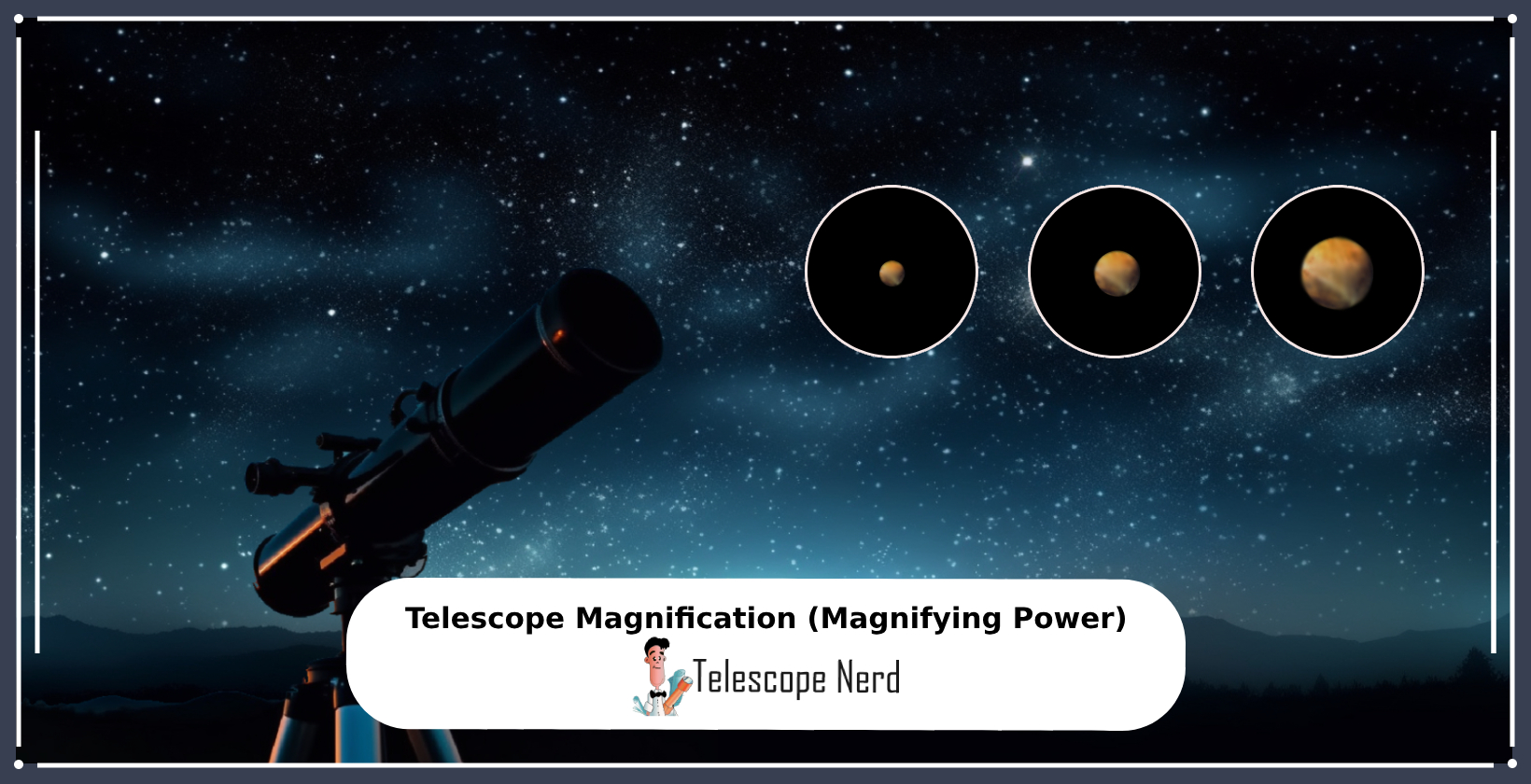Telescope Magnification (Magnifying Power)
Telescope magnification, often referred to as “power” or “telescope zoom,” defines how much a telescope can enlarge the appearance of distant objects. Magnification is the factor by which a telescope amplifies the size of an object compared to its size as seen with the naked eye.
A telescope’s magnifying power is determined by dividing the focal length of the telescope by the focal length of the eyepiece. Therefore, decreasing the focal length of the eyepiece or increasing the focal length of the telescope will increase the telescope’s magnification.
Knowing this value is essential for astronomers, because it allows them to choose the right eyepiece for their observational goals. Planets require different magnifications and fields of view (FOVs), therefore observers must calculate the necessary eyepiece diameter. As the magnification increases, the field of view decreases, showing a smaller portion of the picture.
What is Telescope Magnification?
Telescope magnification, often referred to as “power”, is a critical characteristic that defines how much a telescope enlarges the appearance of distant objects. The magnification determines how much closer celestial objects appear to the observer. This value is the factor by which a telescope amplifies the size of an object compared to its size as seen with the naked eye. For instance, a telescope with a magnification of 100x makes an object appear 100 times larger than it would appear to the unaided eye.
Telescope magnification works by bending light rays through its lenses or mirrors to create an image. The image is then magnified by the eyepiece, making the object appear larger and closer than it is. The magnification depends on the combination of the telescope’s focal length and the eyepiece’s focal length.
Magnification is measured in a unitless value represented as ‘x’, which stands for ‘times’. For example, a magnification of 50x means the object appears 50 times closer or larger than it would to the naked eye. Interestingly, magnification can be less than one, often the case with certain types of binoculars or spotting scopes, where the image appears smaller than it would to the naked eye.
Another important concept related to telescope magnification is angular magnification. It measures the angle subtended by the image at the observer’s eye compared to the actual object. This type of magnification is crucial in astronomy, where distances are vast, and objects are observed at different angles. Angular magnification is also a unitless value, as it is a ratio of the angles subtended by the image and the object.
Understanding magnification is essential for astronomers to choose the right eyepiece and get the best image and viewing experience. One of the ways to understand magnification is to calculate it.
How to Calculate the Magnification of a Telescope?
To calculate the magnification of a telescope divide the focal length of the telescope by the focal length of the eyepiece. This can be done by using a telescope magnification calculator or by employing the following formula.
Magnification = Telescope Focal length (mm) / Eyepiece Focal length (mm)
For example, a telescope with a focal length of 1000mm, using an eyepiece with a focal length of 10mm, would have a magnification of 100x.
How to calculate the highest possible magnification? The rule of thumb for calculating the maximum useful magnification is 2 multiplied by the aperture size in millimeters(mm). However, this is a theoretical limit and the actual maximum magnification is affected by factors such as atmospheric conditions and the quality of the telescope’s optics. The quality of a telescope’s optics encompasses the alignment, polishing and coating. Small flaws, such as scratches, also play an influential role in optical quality.
Knowing how to calculate the magnification is important because it allows the observer to choose the right eyepiece for their observational goals. For example, a higher magnification is needed to observe the details of planets, while a lower magnification is better for viewing larger objects like nebulae.
Angular magnification is a measure of how much larger the angle subtended by an object appears when viewed through the telescope compared to the naked eye. In telescopes, the objects being observed are so distant, the increase in the subtended angle effectively corresponds to the magnification. Therefore, dividing a telescope’s focal length by the eyepiece focal length will also reveal the angular magnification.
Eyepieces play an influential role in determining magnification. Different eyepieces have different focal lengths, and by changing the eyepiece, astronomers are able to adjust the magnification of the telescope. Therefore, having a range of eyepieces with different focal lengths is beneficial for observers who want to view a variety of celestial objects.
How Does an Eyepiece Affect Telescope Magnification?
Eyepiece directly affect magnification. By altering the eyepiece, different levels of magnification can be achieved. This is possible because various eyepieces provide varying levels of magnification.
The eyepiece is a lens or a group of lenses positioned at the end of a telescope, enabling observers to view the image. The primary function of the eyepiece is to magnify the image produced by the telescope’s primary lens or mirror.
A key factor in determining the magnification is the focal length of the eyepiece. If an eyepiece has a shorter focal length, it will result in higher magnification, while a longer focal length will lead to lower magnification. Thus, changing the eyepiece provides the opportunity to select a magnification level appropriate for specific observing needs.
To maximize the magnification of the telescope, one should choose an eyepiece with the shortest focal length possible. This would result in the highest achievable magnification for the telescope’s optics.
When observing celestial objects, such as planets, the choice of eyepiece becomes crucial. Planets appear relatively small in the night sky, so using an eyepiece with high magnification allows observers to see finer details and make the planets appear larger and more prominent.
What Telescope Magnification is Needed to See Planets?
The required magnification vary from as little as 25x to over 100x, depending on the observation. Below are a few examples of telescope magnification to see specific planets.
- To see Saturn’s rings, a magnification within a range of 25x to 50x is needed.
- To see Lunar Landing Sites, a magnification within a range of 30x to 75x is needed.
- To see Mars’ surface details, a magnification within a range of 75x to 150x is needed.
- To see Jupiter’s Great Red Spot, a magnification within a range of 100x to 120x is needed.
These values are approximate and vary depending on the telescope’s aperture, the clarity of the atmosphere, and the planet’s position in the sky. Increasing the magnification will help in viewing these celestial bodies more clearly.
Is it Possible to Increase the Magnification of a Telescope?
Yes, it is possible to increase the magnification of a telescope. This can be achieved by using an eyepiece with a shorter focal length or by using a Barlow lens, which effectively increases the focal length of the telescope. However, it’s important to note that increasing magnification also amplifies atmospheric disturbances and reduces the brightness and field of view of the image.
How Does Focal Length Affect Telescope Magnification?
Focal length directly affects magnification, the longer the focal length of a telescope, the higher the magnification, and vice versa. Telescope focal length is the distance from the telescope’s primary lens or mirror to the point where the light rays come together to form a focused image.
Magnification is the quotient of the telescope’s focal length and the eyepiece’s focal length, therefore an increase in focal length will also increase magnification. For example, a telescope with a 1000mm focal length and an eyepiece with a 10mm diameter will yield a 100x magnification. However, a telescope with a focal length of 600mm and an eyepiece with a diameter of 10mm will have a 60x magnification.
While focal length does influence magnification, the magnifying power also depends on the focal length of the eyepiece. A shorter eyepiece focal length increases the magnification, while a longer eyepiece focal length will decrease the magnification. The field of view (FOV) also correlates with magnification as it is influenced by the same factors.
How Does Magnification Relate to Field of View?
As the magnification increases, the telescope’s field of view decreases. In other words, at higher magnifications, the observer sees a smaller area, but with more detail. Conversely, when using lower magnifications, the observer can see a larger area, but with less detail. The telescope field of view (FOV) refers to the extent of the observable world or the diameter of the area that is seen through a telescope’s eyepiece at any given moment. The relationship between magnification and FOV in telescopes is crucial to understanding a telescope’s capabilities.
When observing large celestial objects like nebulae, using lower magnification and higher FOVs allows to capture a broader view, enabling a better appreciation of the object’s overall structure and context within its surroundings. On the other hand, when tracking moving objects like planets, higher magnification and lower FOVs are preferable to reveal finer details on their surfaces.
Understanding the interplay between magnification and field of view is crucial to how a telescope works, as it helps astronomers choose the appropriate eyepiece for their observational goals. It ensures they can optimize their viewing experience and gather relevant information about the celestial objects they are studying.
Why is Magnification Important for Telescopes to Work?
Magnification is important for telescopes to work because it allows astronomers to observe distant celestial objects in greater detail. Without magnification, it would be impossible to study the moon’s craters, Jupiter’s bands, or the rings of Saturn.
How does a telescope work to magnify images? A telescope gathers light by using a large objective lens or mirror, then focusing that light into a point to form an image. The eyepiece then magnifies this image to allow observers to view distant objects.
It’s important to remember that higher magnification doesn’t always mean better views. Other components, including the aperture size and atmospheric conditions, also play a role in how a telescope works, impacting the quality of an image.
In summary, magnification allows telescopes to fulfill their primary purpose of providing closer views of distant celestial objects, aiding astronomers in their observations and expanding our understanding of the universe.

